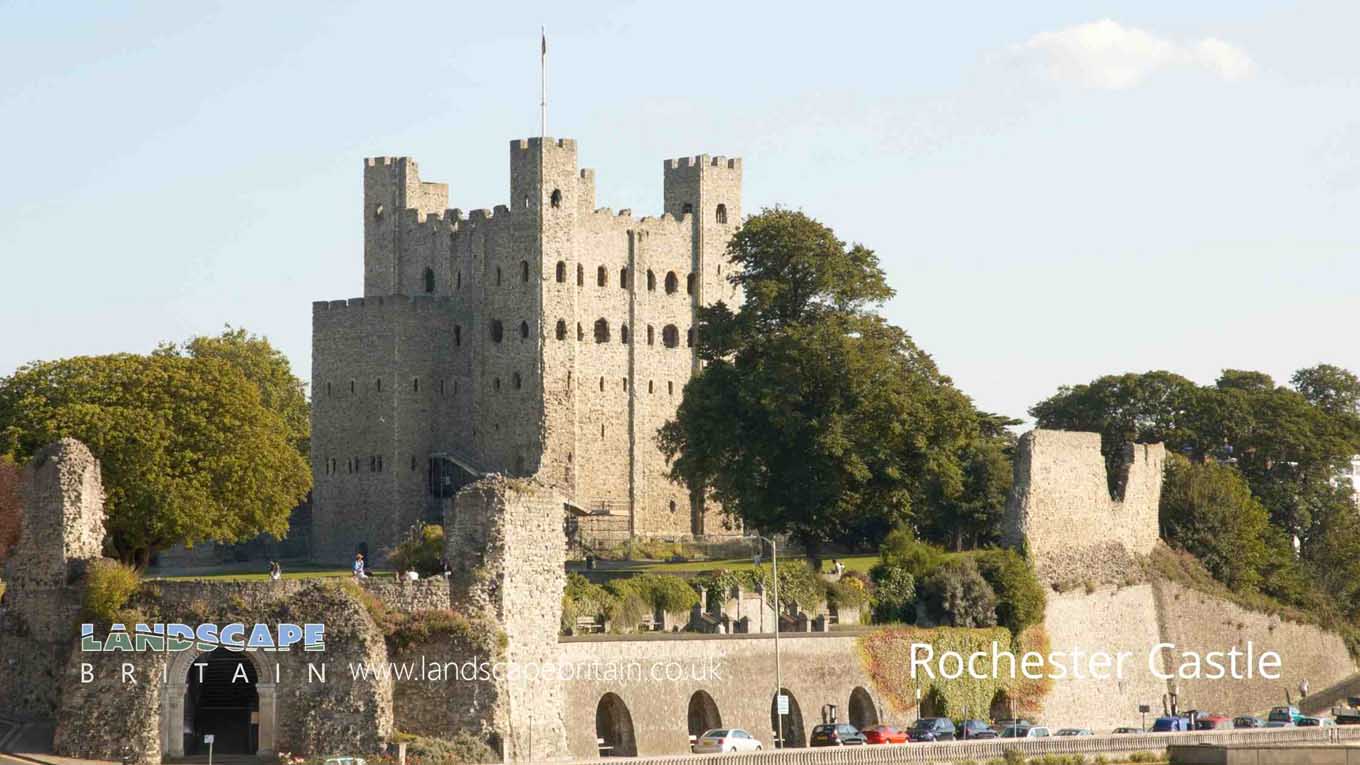
Rochester Castle
Rochester Castle
The building of the first castle began under William Rufus, with stone walls seven feet thick at their base, enclosing about twenty acres. The inner wall had towers placed on it, eight on each side of the square-shaped keep.
The keep of Rochester Castle stands up to seventy feet tall. The walls were originally covered with plaster and brightly painted murals depicting famous battles between English kings and Normans.
The Norman style of architecture used at Rochester Castle is considered to be a rare and speciality. In the mid 1070’s William de Corbeil, Archbishop of Canterbury added a chapel with huge Romanesque columns supporting a decorated arch. Although many Norman castles have round towers the ones at Rochester were built in a hexagonal shape, another unique feature in this castle. A tall square tower was added to each corner extending beyond the rest of the walls for extra defense at corners which were often attacked first during siege events (such as this one). This provides anextra wall for the defenders to shoot arrows down on attacking soldiers. The towers were also used as a place for guards to keep watch over the surrounding area, with some of them having holes in the floor which allowed defenders to drop stones or hot oil on attackers who may have made it past the first line of defense.
This style of architecture is very different from that built by William’s contemporary brother, Robert Curthose, Duke of Normandy, who built most of his castles using his own unique design incorporating more circular shapes into its structure.
Rochester became an important castle during the early Norman period because whoever controlled Rochester - controlled access between London and Dover. During its active history there was only one occurrence where soldiers successfully breached its walls.
Rochester was besieged three times in its history. The first siege started on April 28th, 1188 against Richard I by his brother, Prince John. The second siege began in 1215 when supporters of a barons’ rebellion tried to take control from King John while he stayed at the castle from May until November. In 1642 during the English Civil War Royalists took refuge there but finally surrendered when they ran out of gunpowder and food supplies were running low.
Created: 30 October 2021 Edited: 29 November 2023
Rochester Castle Information
Rochester Castle Address
Castle Hill, Rochester
ME1 1SW
Website: https://www.english-heritage.org.uk/visit/places/rochester-castle/
Get directionsRochester Castle LiDAR Map
please wait...
Contains public sector information licensed under the Open Government Licence v3.0
Local History around Rochester Castle
There are some historic monuments around including:
Rochester city wallBrunel Sawmills, Chatham DockyardChatham Dockyard, Dry Docks Nos 2, 3 and 4Chatham Dockyard, the Expense Account Department, Wages DivisionArtillery castle at UpnorChatham Dockyard, the Dockyard wallKit's Coty House Long BarrowLodge Hill Anti-aircraft BatteryChatham Dockyard, Officers' Terrace and gardens to eastBell barrow in Shoulder of Mutton WoodChatham Dockyard, covered slip to N of No 5 SlipChatham Dockyard, Captain of Dockyard's houseChatham Lines, section at Chatham Gun WharfChatham Dockyard, Tarred Yarn StorePalaeolithic siteBrook Low Level Pumping StationChatham Dockyard, two stables SE of Sail LoftFort PittHatchelling House, Chatham DockyardCockham Wood FortChatham Dockyard, Medway HouseChatham Dockyard, the Cashiers' OfficeSite of 17th century dockyardSt Mary's Priory: an alien Benedictine priory 100m east of St Mary's ChurchFort ClarenceChatham Dockyard, bell mast W of Main GateChatham Dockyard, Main GateChatham Dockyard, engine or boiler houseFormer guardhouseChatham Dockyard, No 61 Boat Store, Nos 4 and 5 SlipsChatham Dockyard, Police officesOpen areas within Roman, Saxon and medieval townChatham Dockyard, stables adjacent to terraceChatham Dockyard, South Pumping StationChatham Dockyard, the Painters' Shop and adjacent storeChatham Dockyard, Customs HouseChatham Dockyard, garden wall of Medway houseChatham Dockyard, former working Mast House and Mould LoftChatham Dockyard, Officers' Reading Room and Admirals' Conference RoomRemains of Rochester Priory cloisterTemple Manor, StroodBishop's palace at HallingRoman villa 200m north of churchChatham Dockyard, MCD Joiners' ShopChatham Dockyard, the Joiners' StoresChatham Dockyard, the Wheelwrights' ShopChatham Dockyard, the Lower Boat StoreFort BorstalChatham Dockyard, dockyard churchBrompton LinesFort LutonChatham Dockyard, Storehouse No 3Chatham Dockyard, two 'Vanbrugh' type housesChatham Dockyard, Sail LoftChatham Dockyard, the Mast PondRochester CastleChatham Dockyard, Rigging House No 1 and Storehouse No 2Chatham Dockyard, No 3 Boat StoreChatham Dockyard, Chain Cable shedChatham Dockyard, Naval Store DepartmentChatham Dockyard, Ropery officesCooling Castle and its associated landscaped settingChatham Dockyard, the Main OfficesChatham Dockyard, Assistant Queen's Harbour Master's officeChatham Dockyard, Queen's StairsChatham Dockyard, the RoperyChatham Dockyard, site of South Mast PondFort HorsteadBeacon and pillbox on Beacon HillChatham Dockyard, the Iron StoreBridge ChapelChatham Dockyard, No 1 Smithery.





